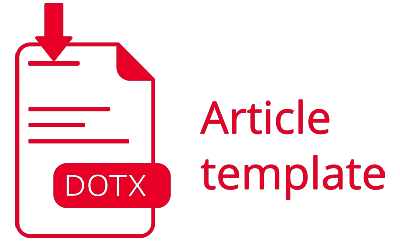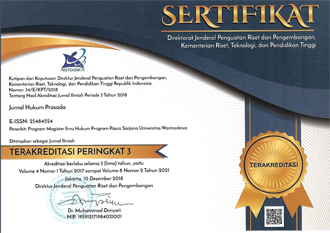Legal Approaches for Clinical Audits and Sanctions in Indonesian Health Service Facilities
Abstract
Laws and regulations in Indonesia have regulated health law to ensure that every person has the right to safe, high-quality, and affordable health services. Article 21 of Law No. 36 of 2009 on Health stipulates that every Health Service Facility must have a good and responsible health service management and governance system. However, the regulation of clinical audits as an effort to reduce the risk of negligence in healthcare facilities and how the process and sanctions for unintended errors in handling patients are still unclear. The research method used is empirical legal research. This research was conducted using the Legislative Approach, Conceptual Approach, and Case Approach. The results show that the regulation of clinical audits as an effort to reduce the risk of negligence in healthcare facilities is still unclear, so an approach based on the principles of justice, legal certainty, and usefulness is needed to reduce the risk of negligence in healthcare facilities. Furthermore, the process of audit and the imposition of sanctions for unintended errors in handling patients in healthcare facilities are subject to civil and criminal lawsuits. The conclusion of this study is that in clinical audits in Indonesia, an approach that prioritizes the principles of justice, legal certainty, and usefulness is needed to reduce the risk of negligence in healthcare facilities, so that all parties are treated equally, sanctions for errors must be fair and proportional, and preventive sanctions should focus on improving the qualifications of health workers, improving systems, and developing policies to improve health services and provide patients with the right to claim compensation and file complaints both civilly and criminally.
References
Ameratunga, R., Hilary, K., Jenny, V., Alan, M., & Jonathan, C.(2019).Criminalisation of Unintentional Error in Healthcare in the UK: A Perspective from New Zealand. BMJ, March 7, l706. https://doi.org/10.1136/bmj.l706.
Amiruddin, A. Z. (2006). Pengantar Metode Penelitian Hukum Jakarta: Raja Grafindo Persada. Cet. Ke-1.
Asmara, G. Y. P., Hartiwiningsih, H., & Isharyanto, I. COMPARING MEDICAL AUDIT SYSTEMS AND REGULATING: A SYSTEMATIC REVIEW. In The 4th Legal Internasional Conference and Studies (Vol. 4, No. 4). Boghossian, Paul. “Rules, Norms and Principles: A Conceptual Framework,†3–11, 2015. https://doi.org/10.1007/978-3-319-09375-8_1.
Brown, G. C., Brown, M. M., & Sharma, S. (2000). Health care in the 21st century: evidence-based medicine, patient preference-based quality, and cost effectiveness. Quality Management in Healthcare, 9(1), 23-31.KBBI Daring. “Audit,†2022. https://kbbi.kemdikbud.go.id/entri/audit.
Cowan, P. J. (2002). The role of clinical audit in risk reduction. British Journal of Clinical Governance, 7(3), 220-223.
Dananjaya, A. N. D., Dewi, A. A. S. L., & Suryani, L. P. (2019). Sanksi malpraktik dan resiko medik yang dilakukan oleh dokter. Jurnal Analogi Hukum, 1(1), 6-10
Direktur Jenderal Pelayanan Kesehatan.(2022) Keputusan Direktur Jenderal Pelayanan Kesehatan Nomor HK.02.02/I/0522/2022 Tentang Pedoman Pelaksanaan Audit Klinis di Rumah Sakit.
DM, M. Y., Yunis, H., Hasibuan, H., & Saragih, G. M. (2023). Analisis Yuridis Terhadap Tindakan Malpraktik Yang Dilakukan Oleh Tenaga Medis. Jurnal Pendidikan dan Konseling (JPDK), 5(1), 84-91.
Hanskamp-Sebregts, M., Robben, P. B., Wollersheim, H., & Zegers, M. (2020). Transparency about internal audit results to reduce the supervisory burden: A qualitative study on the preconditions of sharing audit results. Health Policy, 124(2), 216-223..
Hikmawati, P. (2017). Pidana Pengawasan Sebagai Pengganti Pidana Bersyarat Menuju Keadilan Restoratif (Criminal Conditional Supervision As a Substitute of Probation Sentence Towards Restorative Justice). Negara Hukum: Membangun Hukum Untuk Keadilan Dan Kesejahteraan, 7(1), 71-88.
Kieslich, K., & Littlejohns, P. (2015). Does accountability for reasonableness work? A protocol for a mixed methods study using an audit tool to evaluate the decision-making of clinical commissioning groups in England. BMJ open, 5(7), e007908.
Khanna, S., & Srivastava, S. (2020). Patient-centric ethical frameworks for privacy, transparency, and bias awareness in deep learning-based medical systems. Applied Research in Artificial Intelligence and Cloud Computing, 3(1), 16-35.
Made, W. P. I. (2022). Ideologi Pancasila Sebagai Dasar Tujuan Pemidanaan dalam Pembaharuan Hukum Pidana Nasional. Vyavahara Duta, 17(1), 55-64.
Mannasa, Y. A., & Fakhriah, E. L. Legal Protection of Doctors as Health Services Providers: Implementing the Balance Principle in Indonesia. International Journal of Innovation, Creativity and Change, 10.
Koto, I., & Asmadi, E. (2021). Pertanggungjawaban Hukum Terhadap Tindakan Malpraktik Tenaga Medis di Rumah Sakit. Volksgeist: Jurnal Ilmu Hukum dan Konstitusi, 181-192.
Menteri Kesehatan Republik Indonesia. Keputusan Menteri Kesehatan Republik Indonesia Nomor HK.01.07/MENKES/1128/2022 Tentang Standar Akreditasi Rumah Sakit (2022).
Moreso, J. J., & Chilovi, S. (2018). Interpretive Arguments and the Application of the Law. Handbook of legal reasoning and argumentation, 495-517.
Ningsih, Desy Kartika, Dey Ravena, and Agus Hadian Rahim. “Settlement of Medical Crimes by the Medical Committee and Medical Audit.†International Journal of Law and Society (IJLS) 2, no. 3 (July 20, 2023): 189–205. https://doi.org/10.59683/ijls.v2i3.37.
Nundy, S., Kakar, A., & Bhutta, Z. A. (2022). How to Practice Academic Medicine and Publish from Developing Countries?: A Practical Guide (p. 465). Springer Nature.
Presiden Republik Indonesia.(2004) Undang-Undang Nomor 29 Tahun 2004 Tentang Praktik Kedokteran.
Robertson, J. J., & Long, B. (2018). Suffering in silence: medical error and its impact on health care providers. The Journal of emergency medicine, 54(4), 402-409.Rose, Nicole, and Daniel S J Pang. “Review Article Compte Rendu A Practical Guide to Implementing Clinical Audit.†Canadian Veterinary Journal 62, no. 5 (2021): 145.
Rothschild, J. M., Landrigan, C. P., Cronin, J. W., Kaushal, R., Lockley, S. W., Burdick, E., ... & Bates, D. W. (2005). The Critical Care Safety Study: The incidence and nature of adverse events and serious medical errors in intensive care. Critical care medicine, 33(8), 1694-1700.Samanta, Ash, Jo Samanta, and Michael Gunn. “Legal Considerations of Clinical Guidelines: Will NICE Make a Difference?†Journal of the Royal Society of Medicine 96, no. 3 (March 23, 2003): 133–38. https://doi.org/10.1177/014107680309600310.
Shidarta, S. (2020). Bernard Arief Sidharta: Dari Pengembanan Hukum Teoretis ke Pembentukan Ilmu Hukum Nasional Indonesia. Undang: Jurnal Hukum, 3(2), 441-476.
Siswati, Sri.(2013). Etika Dan Hukum Kesehatan Dalam Perspektif Undang-Undang Kesehatan. Jakarta: Rajawali Pers.
Soekidjo, N. (2010). Etika dan hukum kesehatan. Jakarta: Rineka Cipta, 44.
Ta’adi, N., & Angelina, B. (2013). Hukum Kesehatan Sanksi dan Motivasi Bagi Perawat. Penerbit Buku Kedokteran EGC, Jakarta.
 Abstract viewed = 104 times
Abstract viewed = 104 times
 PDF downloaded = 105 times
PDF downloaded = 105 times








